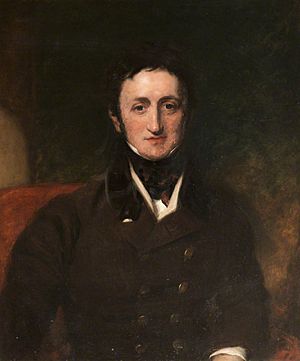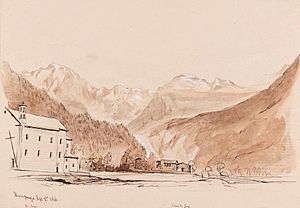John Scandrett Harford facts for kids
Quick facts for kids
John Scandrett Harford
|
|
|---|---|

John Scandrett Harford, portrait after Sir Thomas Lawrence
|
|
| Born | 8 October 1785 |
| Died | 16 April 1866 (aged 80) Blaise Castle, Bristol
|
John Scandrett Harford (born October 8, 1785 – died April 16, 1866) was an important person in Britain. He was a banker, which means he worked with money. He was also a kind helper to many people and a strong supporter of ending slavery. He was known as a Fellow of the Royal Society (FRS), a special group for top scientists and thinkers.
Early Life
John Scandrett Harford grew up in Bristol. His father, also named John Scandrett Harford, was a rich banker and landowner. The family were Quakers, a type of Christian group known for their simple life and peaceful beliefs.
Young John was raised as a Quaker. However, in 1809, he joined the Church of England. He went to school and later studied at Christ's College, Cambridge. He was a close friend of William Wilberforce, who was famous for working to end slavery. Harford also believed that slavery should be stopped.
Family Homes
The Harford family owned several properties. One important home was the Blaise Castle Estate near Henbury. This estate had been owned by someone else who lost his money. John Harford the elder bought the land and buildings.
He had a large house built there. He also hired a famous landscape designer, Humphry Repton, to plan the beautiful gardens. Repton worked with John Nash, another well-known architect.
Harford asked Nash to design a group of small houses called Blaise Hamlet. These pretty cottages were built for his retired servants to live in. Diamond Cottage is a good example of the charming style of these homes.
In 1819, Harford and his younger brothers also bought the Peterwell estate in Lampeter. This land had once belonged to his father-in-law. Later, Harford's nephew, John Battersby Harford, changed the house there. He made it look like an Italian-style building and named it Falcondale.
Supporting Education
John Harford the elder helped support schools run by Hannah More in the 1790s. These schools helped educate children. Some people even thought that a character in a popular book was based on the younger John Harford.
In 1820, Harford met Thomas Burgess, a bishop. Burgess wanted to start a college for religious education in South Wales. Harford believed that a college in Lampeter would help the area grow and improve.
So, in late 1820, Harford offered to give Burgess the land for the college. This land was called 'Castle Field' or 'Cae Castell'. Today, the University of Wales Trinity Saint David (which used to be St David's College) stands on this land. There is a statue of Harford at the university. Also, two student dorms there are named Harford I and Harford II, in his honor.
Later Life and Achievements
Harford was chosen as the High Sheriff of Cardiganshire for 1825–26. This was an important local role.
He was also a talented artist. His oil paintings can sometimes be found at art sales in the UK. In 1823, he became a Fellow of the Royal Society, which is a great honor for people in science and arts. He was also the first president of the Royal West of England Academy (then called the Bristol Academy of Fine Arts). He led this art academy from 1844 until 1859.
In his later years, John Harford lost his eyesight. He passed away at Blaise Castle in 1866. He did not have any children. His nephew, John Battersby Harford, inherited his property.
See also


